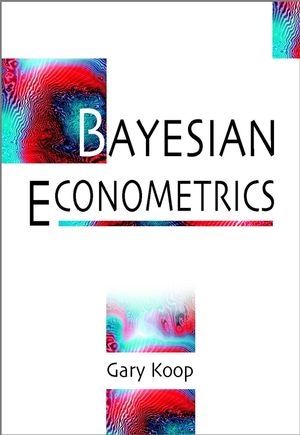
Bayesian Econometrics
Wiley-Interscience (Verlag)
978-0-470-84567-7 (ISBN)
Bayesian Econometrics introduces the reader to the use of Bayesian methods in the field of econometrics at the advanced undergraduate or graduate level. The book is self-contained and does not require that readers have previous training in econometrics. The focus is on models used by applied economists and the computational techniques necessary to implement Bayesian methods when doing empirical work. The book includes numerous empirical examples and the website associated with it contains data sets and computer programs to help the student develop the computational skills of modern Bayesian econometrics.
Gary Koop is Professor of Economics at the University of Glasgow.
Preface xiii
1 An Overview of Bayesian Econometrics 1
1.1 Bayesian Theory 1
1.2 Bayesian Computation 6
1.3 Bayesian Computer Software 10
1.4 Summary 11
1.5 Exercises 11
2 The Normal Linear Regression Model with Natural Conjugate Prior and a Single Explanatory Variable 15
2.1 Introduction 15
2.2 The Likelihood Function 16
2.3 The Prior 18
2.4 The Posterior 19
2.5 Model Comparison 23
2.6 Prediction 26
2.7 Empirical Illustration 28
2.8 Summary 31
2.9 Exercises 31
3 The Normal Linear Regression Model with Natural Conjugate Prior and Many Explanatory Variables 33
3.1 Introduction 33
3.2 The Linear Regression Model in Matrix Notation 34
3.3 The Likelihood Function 35
3.4 The Prior 36
3.5 The Posterior 36
3.6 Model Comparison 38
3.7 Prediction 45
3.8 Computational Methods: Monte Carlo Integration 46
3.9 Empirical Illustration 47
3.10 Summary 54
3.11 Exercises 54
4 The Normal Linear Regression Model with Other Priors 59
4.1 Introduction 59
4.2 The Normal Linear Regression Model with Independent Normal-Gamma Prior 60
4.3 The Normal Linear Regression Model Subject to Inequality Constraints 77
4.4 Summary 85
4.5 Exercises 86
5 The Nonlinear Regression Model 89
5.1 Introduction 89
5.2 The Likelihood Function 91
5.3 The Prior 91
5.4 The Posterior 91
5.5 Bayesian Computation: The Metropolis–Hastings Algorithm 92
5.6 A Measure of Model Fit: The Posterior Predictive P-Value 100
5.7 Model Comparison: The Gelfand–Dey Method 104
5.8 Prediction 106
5.9 Empirical Illustration 107
5.10 Summary 112
5.11 Exercises 113
6 The Linear Regression Model with General Error Covariance Matrix 117
6.1 Introduction 117
6.2 The Model with General 118
6.3 Heteroskedasticity of Known Form 121
6.4 Heteroskedasticity of an Unknown Form: Student-t Errors 124
6.5 Autocorrelated Errors 130
6.6 The Seemingly Unrelated Regressions Model 137
6.7 Summary 143
6.8 Exercises 144
7 The Linear Regression Model with Panel Data 147
7.1 Introduction 147
7.2 The Pooled Model 148
7.3 Individual Effects Models 149
7.4 The Random Coefficients Model 155
7.5 Model Comparison: The Chib Method of Marginal Likelihood Calculation 157
7.6 Empirical Illustration 162
7.7 Efficiency Analysis and the Stochastic Frontier Model 168
7.8 Extensions 176
7.9 Summary 177
7.10 Exercises 177
8 Introduction to Time Series: State Space Models 181
8.1 Introduction 181
8.2 The Local Level Model 183
8.3 A General State Space Model 194
8.4 Extensions 202
8.5 Summary 205
8.6 Exercises 206
9 Qualitative and Limited Dependent Variable Models 209
9.1 Introduction 209
9.2 Overview: Univariate Models for Qualitative and Limited Dependent Variables 211
9.3 The Tobit Model 212
9.4 The Probit Model 214
9.5 The Ordered Probit Model 218
9.6 The Multinomial Probit Model 221
9.7 Extensions of the Probit Models 229
9.8 Other Extensions 230
9.9 Summary 232
9.10 Exercises 232
10 Flexible Models: Nonparametric and Semiparametric Methods 235
10.1 Introduction 235
10.2 Bayesian Non- and Semiparametric Regression 236
10.3 Mixtures of Normals Models 252
10.4 Extensions and Alternative Approaches 262
10.5 Summary 263
10.6 Exercises 263
11 Bayesian Model Averaging 265
11.1 Introduction 265
11.2 Bayesian Model Averaging in the Normal Linear Regression Model 266
11.3 Extensions 278
11.4 Summary 280
11.5 Exercises 280
12 Other Models, Methods and Issues 283
12.1 Introduction 283
12.2 Other Methods 284
12.3 Other Issues 288
12.4 Other Models 292
12.5 Summary 308
Appendix A: Introduction to Matrix Algebra 311
Appendix B: Introduction to Probability and Statistics 317
B.1 Basic Concepts of Probability 317
B.2 Common Probability Distributions 324
B.3 Introduction to Some Concepts in Sampling Theory 330
B.4 Other Useful Theorems 333
Bibliography 335
Index 347
| Erscheint lt. Verlag | 28.4.2003 |
|---|---|
| Sprache | englisch |
| Maße | 171 x 246 mm |
| Gewicht | 595 g |
| Themenwelt | Wirtschaft ► Volkswirtschaftslehre ► Ökonometrie |
| ISBN-10 | 0-470-84567-8 / 0470845678 |
| ISBN-13 | 978-0-470-84567-7 / 9780470845677 |
| Zustand | Neuware |
| Informationen gemäß Produktsicherheitsverordnung (GPSR) | |
| Haben Sie eine Frage zum Produkt? |
aus dem Bereich


